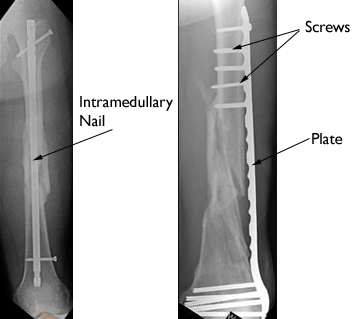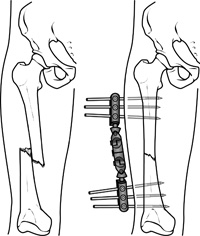Internal Fixation for Fractures
A broken bone must be carefully stabilized and supported until it is strong enough to handle the body's weight and movement. Until the last century, physicians relied on casts and splints to support and stabilize the bone from outside the body. The advent of sterile surgical procedures reduced the risk of infection, allowing doctors to internally set and stabilize fractured bones.
During a surgical procedure to set a fracture, the bone fragments are first repositioned (reduced) into their normal alignment. They are held together with special implants, such as plates, screws, nails and wires.
Internal fixation allows shorter hospital stays, enables patients to return to function earlier, and reduces the incidence of nonunion (improper healing) and malunion (healing in improper position) of broken bones.
The implants used for internal fixation are made from stainless steel and titanium, which are durable and strong. If a joint is to be replaced, rather than fixed, these implants can also be made of cobalt and chrome. Implants are compatible with the body and rarely cause an allergic reaction.
Plates
Plates are like internal splints that hold the broken pieces of bone together. They are attached to the bone with screws. Plates may be left in place after healing is complete, or they may be removed (in select cases).
Screws
Screws are used for internal fixation more often than any other type of implant. Although the screw is a simple device, there are different designs based on the type of fracture and how the screw will be used. Screws come in different sizes for use with bones of different sizes. Screws can be used alone to hold a fracture, as well as with plates, rods, or nails. After the bone heals, screws may be either left in place or removed.
Nails or Rods
In some fractures of the long bones the best way to hold the bone pieces together is by inserting a rod or nail through the hollow center of the bone that normally contains some marrow. Screws at each end of the rod are used to keep the fracture from shortening or rotating, and also hold the rod in place until the fracture has healed. Rods and screws may be left in the bone after healing is complete. This is the method used to treat the majority of fractures in the femur (thighbone) and tibia (shinbone).
 (Left) This x-ray shows a healed thighbone fracture treated with intramedullary nailing. (Right) In this x-ray, the thighbone fracture has been treated with plates and screws.
(Left) This x-ray shows a healed thighbone fracture treated with intramedullary nailing. (Right) In this x-ray, the thighbone fracture has been treated with plates and screws.
Wires/Pins
Wires are often used to pin the bones back together. They are often used to hold together pieces of bone that are too small to be fixed with screws. In many cases, they are used in conjunction with other forms of internal fixation, but they can be used alone to treat fractures of small bones, such as those found in the hand or foot. Wires are usually removed after a certain amount of time, but may be left in permanently for some fractures.
External Fixators
An external fixator acts as a stabilizing frame to hold the broken bones in proper position. In an external fixator, metal pins or screws are placed into the bone through small incisions into the skin and muscle. The pins and screws are attached to a bar outside the skin. Because pins are inserted into bone, external fixators differ from casts and splints which rely solely on external support.
In many cases, external fixation is used as a temporary treatment for fractures. Because they are easily applied, external fixators are often put on when a patient has multiple injuries and is not yet ready for a longer surgery to fix the fracture. An external fixator provides good, temporary stability until the patient is healthy enough for the final surgery.
Other times, an external fixator can be used as the device to stabilize the bone until healing is complete.
There may be some inflammation or, less commonly, infection associated with the use of external fixators. This is typically managed with wound care and/or oral antibiotics.

External fixation is often used to hold the bones together temporarily when the skin and muscles have been injured.
Other Considerations
Sterile conditions and advances in surgical techniques reduce, but do not remove, the risk of infection when internal fixation is used. The severity of the fracture, its location, and the medical status of the patient must all be considered.
In addition, no technique is foolproof. The fracture may not heal properly or the plate or rod may break or deform. Although some media attention has focused on the possibility that cancer could develop near a long-term implant, there is little evidence documenting an actual cancer risk and much evidence against that possibility. Orthopaedic surgeons are continuing their research to develop improved methods for treating fractures.
Article can be found at : http://orthoinfo.aaos.org/topic.cfm?topic=a00196

